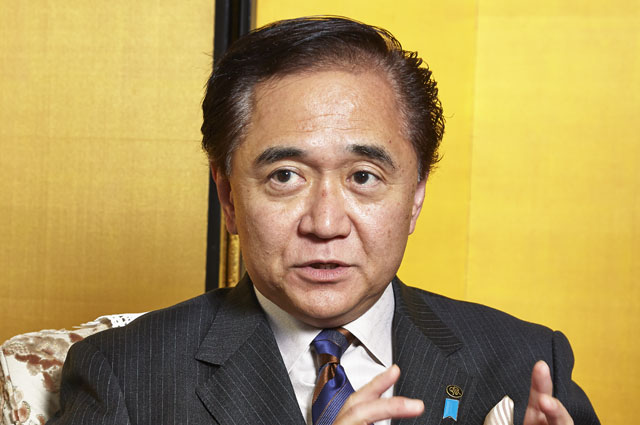Governor Yuji Kuroiwa says Kanagawa is like a microcosm of Japan. It is a place where you can find mountains, coastline, major metropolises like Yokohama and Kawasaki, historical ports, samurai culture in Kamakura, rice fields and farms with some of the best produce in the country, hot springs in Hakone that pull millions of visitors each year and rivers and lakes with camp grounds that help people enjoy the great outdoors.
Interview by Matthew Holmes and Ray Pedersen
But how did the man whose media career spanned more than 20 years and who is a household name in Japan end up in charge of not only running the prefecture he now calls home from his office in Yokohama, but with spreading the word?
When he was a child growing up in Kobe he wanted to be a politician, with dreams of changing the world, “changing the troublesome things,” Kuroiwa, who is 58, tells us. When he matured, though, he realized that with the level of energy needed to maintain power balances, campaign for office and cope with the infighting that can go with the job, his scope might be limited.
“I was considering the offer for some time, maybe a week, but then the earthquake happened and I had to make up my mind. I saw it as a kind of message that I had to make the move into politics. I knew I could make a difference.”
That’s one major reason he turned to journalism, and it’s why he ended up as a news anchor, hosting political and life science related discussion and panel shows throughout the 80s, 90s and 2000s.
But then in 2011 Shigefumi Matsuzawa, the outgoing Governor of Kanagawa who would leave to challenge in the Tokyo elections, asked him to step into his role.
“I was considering the offer for some time, maybe a week, but then the earthquake happened and I had to make up my mind. I saw it as a kind of message that I had to make the move into politics. I knew I could make a difference.”
There are of course challenges – Kanagawa is more than following the national trend with its ageing population, and industrial centres are of course led by a national economic situation. There are solutions to these problems, though: Kuroiwa is for example working hard on special projects such as creating a hub of research into life sciences and in an area near Haneda that is to be designated a special zone. He’s also looking to improve lifestyles and health throughout the population, lessening future problems before they occur.
Traditionally three areas of Kanagawa have been the most well known – and indeed most heavily promoted by tourism agencies and local government. They are the three that we’d guess would be first to the tongue should we ask: Kamakura, Hakone and Yokohama.
“It is not only those places, though,” he says, “we have a lot of potential.” Other areas that are attractive enough to deserve their own drive towards getting more exposure are plenty, and are diverse enough to allow us to see that really people may not need much persuasion.
“Jogashima, for example, at the bottom of the Miura peninsula, past Kamakura and Hayama, right at the tip just off Misaki, is great. It’s a rich place with gorgeous nature, and really great views, there is fresh seafood and vegetables, and the area’s tuna, which is excellent, is particularly well-known – we’re really proud that the Michelin Green Guide has awarded the area two stars.”
Another area Kuroiwa talks about is Oiso, a stretch of coastline with second homes to many well-known figures and which the government is hoping to give new impetus for growth. Then there is Oyama, a mountain with shrines and temples that was a popular pilgrimage route during the Edo period. It’s within the Tanzawa-Ōyama Quasi-National Park and has great day hikes.
“Tanzawa itself is serious wild mountain country,” Kuroiwa says. “There are even bears there.” As well as nature – and the ‘great outdoors’ – a theme that runs through a lot of the literature you’ll find about Kanagawa is water.
“Because we have a lot of water sources, even in summer we don’t have shortages. But it also means great news for the leisure industry and it really adds to the landscape. There are places to do watersports, for example, and there are places to camp by the river or lake. We are lucky in that respect, compared to some other parts of Kanto.”
Back to the idea of being able to extrapolate aspects of Kanagawa to illustrate a wider Japan, no better is this shown than by in the area’s food and drink, Kuroiwa feels.
“The tuna and other seafood along the coast is excellent, but we also have other things. Soba and tofu from around the Oyama area is particularly good – the fresh water helps that and also means great sake and local craft beers. The Atsugi area has well-known pork – the farms there are really strong on welfare, which makes the meat taste better – and we have Hayama beef and Odawara kamaboko that are known around the country.” Miura peninsula, which can feel fairly temperate, harvests watermelons and strawberries.
Kuroiwa is proud to be the governor of Kanagawa, it is clear. This means his role as not only a leader but as an ambassador and ‘salesman’ for a prefecture that is home to people from 160 nationalities becomes much easier.
“Our strength is that diversity of culture,” Kuroiwa says. “Anybody from any part of the planet can fit into and be welcome in Kanagawa.”
Photograph by Norihisa Kushibiki









